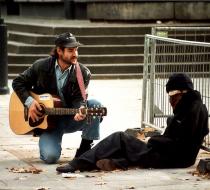The Project Filoctetes 2 Favorite
The protagonism of the body in the dramatization of marginalized groups is also central to Emilio García Wehbi's Proyecto Filoctetes, an urban intervention staged November 15, 2002, on the streets of Buenos Aires. The project consisted in placing twenty-five lifelike latex mannequins in central, highly trafficked locations around the city in varying positions of injury, physical distress, and abandonment. Wehbi and a creative team of over sixty people situated the bodies around the city early in the morning. To each body, a group of three assistants was assigned to document and record the reaction of the passerby. In a statement, Wehbi proclaimed that the purpose of the experiment was to "interrogate in aesthetic terms the possible relationships that can be established in the city between passerby and body, and the possible social consequences of these relationships."
Though the experiment was carried out in the direct aftermath of the economic crises of 2001, Wehbi remarks that he had begun conceptualizing Proyecto Filoctetes on realizing that the urban topography had changed during the ninties under Menem with the increasing presence of homeless people and extreme poor on the street of Buenos Aires.
Critics have cited Giorgio Agamben's work in their reviews of Project Filoctetes because they find particular resonance with his interpretation of "bare life"- life that has not entered the political- and its foundational exclusion from Western politics. In a sense, "Filoctetes" seems to perform the visibilization of bare life in the reinsertion of marginalized bodies in the urban sphere of Buenos Aires. The name Filoctetes itself is a direct reference to the Greek God Philoctetes, a figure who was for into exile on the Greek Island Lemnos because of a malodorous wound that formed on his foot.
Through the placement of lifelike bodies around the city, Filoctetes represents the unrepresented, makes visible the invisible, and documents the undocumented. Most profoundly, the project disrupts urban topography and calls into question the spatial segregation between "winning" and "losing" spaces that were articulated under Menem.
-
An article by B. Werth from the book "Theatre, Performance, and Memory Politics in Argentina"







